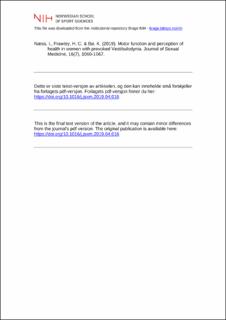| dc.contributor.author | Næss, Ingrid | |
| dc.contributor.author | Frawley, Helena C. | |
| dc.contributor.author | Bø, Kari | |
| dc.date.accessioned | 2020-05-06T06:34:29Z | |
| dc.date.available | 2020-05-06T06:34:29Z | |
| dc.date.created | 2019-06-19T12:52:59Z | |
| dc.date.issued | 2019 | |
| dc.identifier.citation | Journal of Sexual Medicine. 2019, 16(7), 1060-1067. | en_US |
| dc.identifier.issn | 1743-6095 | |
| dc.identifier.uri | https://hdl.handle.net/11250/2653402 | |
| dc.description | I Brage finner du siste tekst-versjon av artikkelen, og den kan inneholde ubetydelige forskjeller fra forlagets pdf-versjon. Forlagets pdf-versjon finner du på sciencedirect.com / In Brage you'll find the final text version of the article, and it may contain insignificant differences from the journal's pdf version. The definitive version is available at sciencedirect.com. | en_US |
| dc.description.abstract | Background Provoked vestibulodynia (PVD) is a prevalent and disabling condition in women that may be associated with reduced quality of life and impairment of physical functioning. Aim To investigate whether women with PVD have different motor functions, posture and breathing patterns, and whether they perceive their physical health differently, compared with asymptomatic controls. Methods and Main Outcome Measure The Standardized Mensendieck Test (SMT) and the Medical Outcomes Study 36-Item Short-Form Health Survey (SF-36) were used to assess differences between 35 women with PVD and 35 healthy controls. Results There were no statistically significant differences in any of the 5 motor domains of the SMT between the women with PVD and those without PVD: standing posture, 4.0 (0.6) vs 5.0 (0.6); gait, 4.7 (0.6) vs 4.8 (0.6); movement, 4.8 (0.8) vs 5.1 (0.6); sitting posture, 4.7 (1.0) vs 4.9 (0.8); respiration, 4.7 (1.0) vs 4.7 (0.9). Women with PVD scored significantly lower in all domains on the SF-36 (adjusted Bonferroni P = .002) except physical functioning. Clinical Implications Given the lack of difference in the SF-36 physical functioning domain and in all 5 domains of the SMT between women with PVD and those without PVD, the value of interventions focusing on general physical function is unclear. Strengths & Limitations A study strength is the use of an assessor-blinded case-control design, trained physiotherapists to conduct the tests, and valid and reliable outcome measures. A limitation is the homogeneity of the sample of young nulliparous women, which limits the generalizability of our findings to other study populations. Conclusion Young nulliparous women with PVD did not score differently from a group of healthy controls on assessment of overall physical functioning or on standing posture, gait, movement, sitting posture, and respiration. However, the score for perception of general health was lower in the women with PVD compared with controls. | en_US |
| dc.language.iso | eng | en_US |
| dc.subject | standardized Mensendieck test | en_US |
| dc.subject | 36-item short-form health survey | en_US |
| dc.subject | provoked vestibulodynia | en_US |
| dc.subject | breathing | en_US |
| dc.subject | motor control | en_US |
| dc.subject | movement | en_US |
| dc.subject | physiotherapy | en_US |
| dc.subject | posture | en_US |
| dc.title | Motor Function and Perception of Health in Women with Provoked Vestibulodynia | en_US |
| dc.type | Peer reviewed | en_US |
| dc.type | Journal article | en_US |
| dc.description.version | acceptedVersion | en_US |
| dc.source.pagenumber | 1060-1067 | en_US |
| dc.source.volume | 16 | en_US |
| dc.source.journal | Journal of Sexual Medicine | en_US |
| dc.source.issue | 7 | en_US |
| dc.identifier.doi | 10.1016/j.jsxm.2019.04.016 | |
| dc.identifier.cristin | 1706067 | |
| dc.description.localcode | Seksjon for idrettsmedisinske fag / Department of Sports Medicine | en_US |
| cristin.ispublished | true | |
| cristin.fulltext | postprint | |
| cristin.qualitycode | 1 | |
